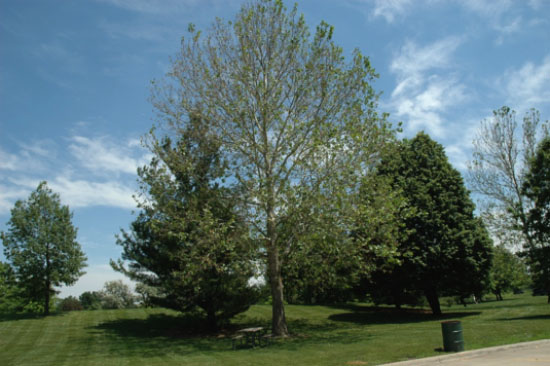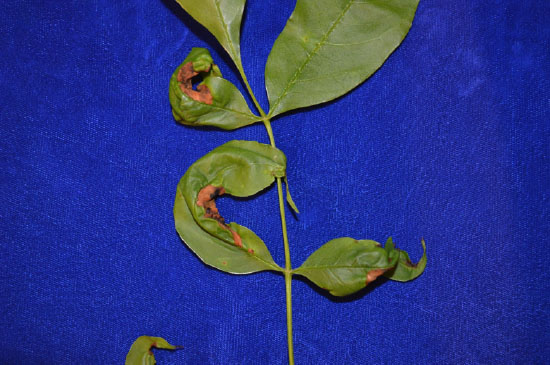Issue 5, June 2, 2014
Anthracnose on Shade Trees: A Review of the Tolerable, the Bad, and the Ugly
Anthracnose samples are just beginning to show up at the Clinic this season. Conditions have been favorable this spring for the development of anthracnose on shade trees. Anthracnose is the disease name designated for a group of closely related pathogens which cause a variety of symptoms including leaf blight and deformation and cankers on stems and branches, though symptoms that develop depend on the tree that is infected. The occurrence of anthracnose on shade trees is favored by cool, wet springs. Anthracnose diseases can be hosted by a number of shade trees including sycamore, ash, and maple.
This disease is very noticeable on sycamores, you can observe what appears to be delayed leafing on the tree and leaves and growing tips dying as they emerge. Upon closer examination of twigs you can find cankers which are sunken, dead looking areas. Cankers on twigs can restrict water and nutrient movement to leaves, resulting in leaf and twig dieback, while cankers on larger branches can girdle and kill entire branches. The small black fruiting bodies of anthracnose which have a "pimple" like appearance (but black) can also be found on twigs and branches. Another symptom you may observe is witches brooming around terminal shoots that were killed by the anthracnose infection.

Sycamore tree with the delayed leafing caused by Anthracnose leaf blight.
Anthracnose also can develop on ash trees. The symptoms you would observe if your ash has anthracnose are dark blotches along the margins of leaves which in turn cause distorted leaves, and small purplish-brown spots located near the leaf centers. The most significant symptom is leaf drop, when new green leaves fall from the tree. Though this disease is not known to cause significant stress to ash trees in a single year, 3 or more consecutive years of heavy defoliation (more than 25% defoliated) of ash trees can leave them more susceptible to other diseases.

Anthracnose leaf blight symptoms on Ash.
Symptoms of anthracnose disease on maple are similar to those of ash: purplish brown blotching along leaf veins that can span out to the leaf margin. That being said, anthracnose is usually not a severe disease on maples. It is more known for detracting from the aesthetic beauty of maples by the discoloration of the leaves, usually no significant defoliation ever occurs.

Anthracnose leaf blight on Maple.
Cultural methods to help control this disease include maintaining proper sanitation of leaves and pruning off and burning (or remove from site) twigs and branches with cankers. Fertilizer can be applied in late fall one month before the first frost or in early spring one month before last frost to help increase tree vigor. Concentrate on boosting tree vitality to promote new growth. Prune in and around the tree to open it to better air movement. Remove dead or dying branches, water in periods of drought, and mark calendars now to fertilize affected trees in the fall. Watering in summer drought is probably the best advice we can give to help infected trees.
Unless anthracnose fungi have repeatedly hit a tree or a very young tree is involved, we do not recommend using fungicides. However, if the problem is severe enough, fungicide sprays can be applied to trees in the early spring when buds begin to swell, and should be applied every 7-14 days when it is a rainy, wet spring as these are conditions most favored by development of anthracnose. Fungicides that will help control anthracnose in shade trees include chlorothalonil, thiophante-methyl, mancozeb, propiconazole, and copper fungicides.
For more information, see Report on Plant Diseases, no. 621 (Adobe PDF). (Chelsea Harbach and Suzanne Bissonnette)